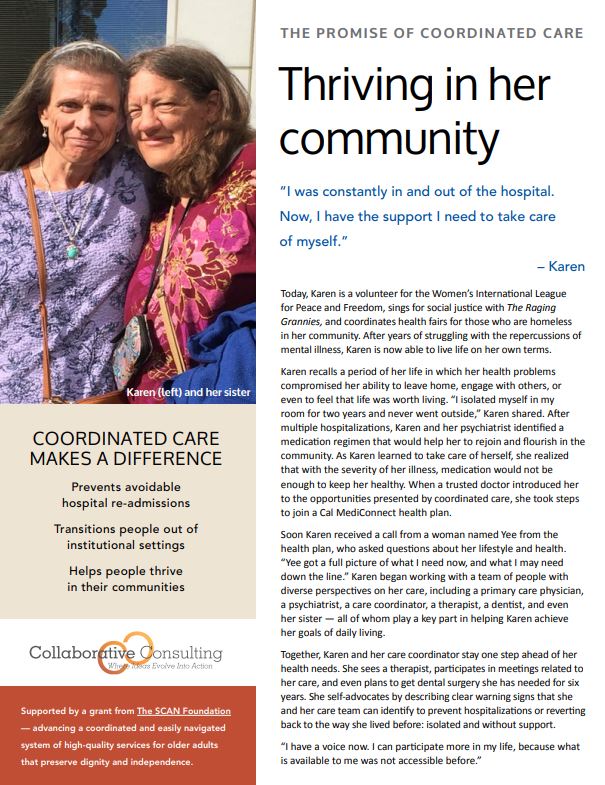The Promise of Coordinated Care: Karen’s Story
summary
Coordinated care makes a difference. It prevents avoidable hospital re-admissions, transitions people out of institutional settings, and helps people thrive in their communities. Read Karen’s case study.
Date Updated: 01/18/2016The Promise of Coordinated Care
Thriving in her Community
Today, Karen is a volunteer for the Women’s International League for Peace and Freedom, sings for social justice with The Raging Grannies, and coordinates health fairs for those who are homeless in her community. After years of struggling with the repercussions of mental illness, Karen is now able to live life on her own terms.
Karen recalls a period of her life in which her health problems compromised her ability to leave home, engage with others, or even to feel that life was worth living. “I isolated myself in my room for two years and never went outside,” Karen shared. After multiple hospitalizations, Karen and her psychiatrist identified a medication regimen that would help her to rejoin and flourish in the
community. As Karen learned to take care of herself, she realized that with the severity of her illness, medication would not be enough to keep her healthy. When a trusted doctor introduced her
to the opportunities presented by coordinated care, she took steps to join a Cal MediConnect health plan.
“I was constantly in and out of the hospital. Now, I have the support I need to take care of myself.” – Karen
Soon Karen received a call from a woman named Yee from the health plan, who asked questions about her lifestyle and health. “Yee got a full picture of what I need now, and what I may need
down the line.” Karen began working with a team of people with diverse perspectives on her care, including a primary care physician, a psychiatrist, a care coordinator, a therapist, a dentist, and even her sister — all of whom play a key part in helping Karen achieve her goals of daily living.
Together, Karen and her care coordinator stay one step ahead of her health needs. She sees a therapist, participates in meetings related to her care, and even plans to get dental surgery she has needed for six years. She self-advocates by describing clear warning signs that she and her care team can identify to prevent hospitalizations or reverting back to the way she lived before: isolated and without support.
“I have a voice now. I can participate more in my life, because what is available to me was not accessible before.”
Download the publication for all visuals and complete references.
Continue Reading
This is the third report coming from the California Medicaid Research Institute (CAMRI) project entitled: Comprehensive Analysis of Home- and Community-Based Services in California. The report describes Medicare and Medi-Cal spending for those beneficiaries using long-term services and supports funded by Medi-Cal.
The California Medicaid Research Institute (CAMRI) developed an integrated and longitudinal database containing Medi-Cal and Medicare claims and assessment data of LTSS recipients in California in 2008. CAMRI’s integrated database provides a unique opportunity to look at characteristics and program spending across the entire care continuum for beneficiaries with LTSS needs within Medi-Cal and for dual eligibles across Medicare and Medi-Cal. This report focuses on LTSS use and spending in the eight duals demonstration counties.
On March 27, 2013, the State of California and the Centers for Medicare and Medicaid Services (CMS) formalized a Memorandum of Understanding (MOU) to establish a Federal-State partnership to implement the Dual Eligibles Integration Demonstration, also referred to as Cal MediConnect. This Fact Sheet provides background information about Cal MediConnect and summarizes the key points of the MOU.


